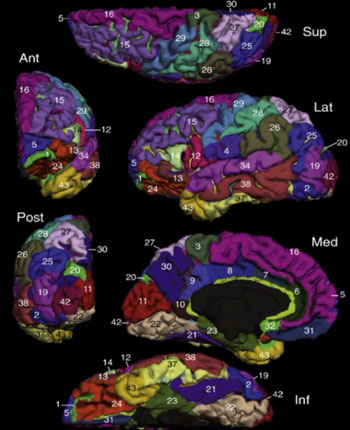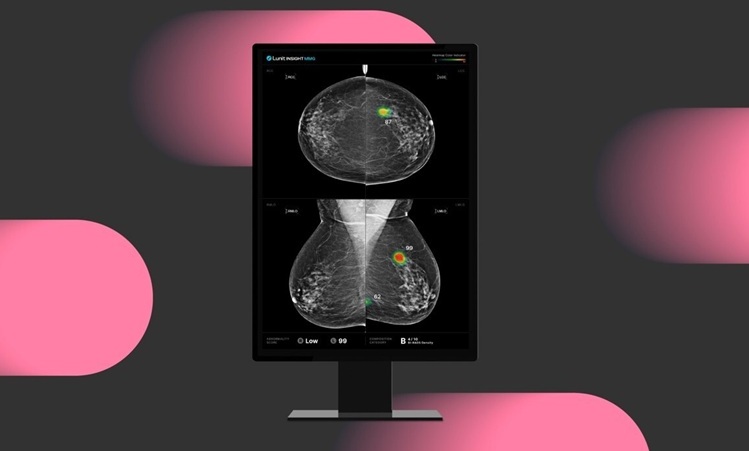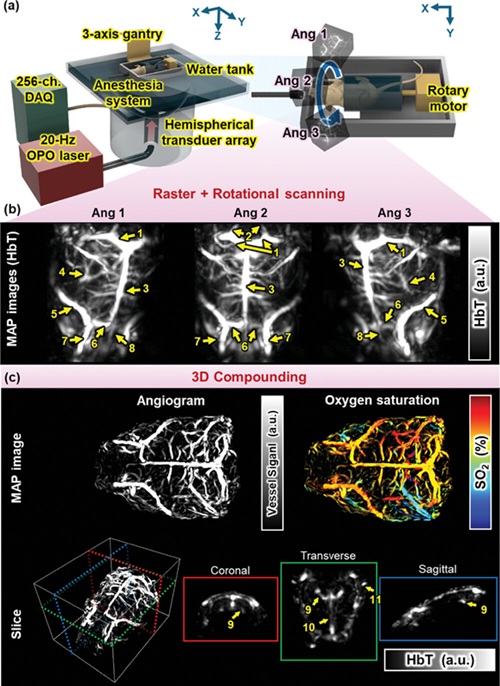MRI Data Shows Human Brain Can Reverse Effects of Schizophrenia
|
By MedImaging International staff writers Posted on 14 Jun 2016 |

Image: The Destrieux atlas shows the manual parcellation and the anatomical regions of one hemisphere of the human brain (Photo courtesy of Dr. Lena Palaniyappan).
The results of an international study indicate that the brains of schizophrenia patients can heal, and can reorganize and fight the disease.
Schizophrenia is associated a widespread reduction in the volume of brain tissue, but there is also a small increase in brain tissue in other regions. The researchers were able to record this increase using Magnetic Resonance Imaging (MRI) covariance analysis. The researchers enrolled 98 schizophrenia patients, and 83 control patients without the disease.
The research was published in a study entitled ‘Dynamic cerebral reorganization in the pathophysiology of schizophrenia: a MRI-derived cortical thickness study’ that was published online on May 26, 2016, in the journal Psychological Medicine. The research was carried out by scientists at the Robarts Research Institute, Western University (London, ON, Canada) University of Nottingham, (Nottingham, UK), and in universities and institutes in China, and one institute in Canada.
The results showed that a reduction in cortical thickness in the brain was accompanied by increased thickness in distributed regions of the brain, and that there was reduced deviation from the control patients with increasing duration of the illness.
The researchers concluded that subtle reorganization of the cerebrum indicates that the brain has an inherent plasticity that may occur in parallel with tissue reduction in adult schizophrenia patients.
Related Links:
Robarts Research Institute
University of Nottingham
Schizophrenia is associated a widespread reduction in the volume of brain tissue, but there is also a small increase in brain tissue in other regions. The researchers were able to record this increase using Magnetic Resonance Imaging (MRI) covariance analysis. The researchers enrolled 98 schizophrenia patients, and 83 control patients without the disease.
The research was published in a study entitled ‘Dynamic cerebral reorganization in the pathophysiology of schizophrenia: a MRI-derived cortical thickness study’ that was published online on May 26, 2016, in the journal Psychological Medicine. The research was carried out by scientists at the Robarts Research Institute, Western University (London, ON, Canada) University of Nottingham, (Nottingham, UK), and in universities and institutes in China, and one institute in Canada.
The results showed that a reduction in cortical thickness in the brain was accompanied by increased thickness in distributed regions of the brain, and that there was reduced deviation from the control patients with increasing duration of the illness.
The researchers concluded that subtle reorganization of the cerebrum indicates that the brain has an inherent plasticity that may occur in parallel with tissue reduction in adult schizophrenia patients.
Related Links:
Robarts Research Institute
University of Nottingham
Latest MRI News
- Ultra-Powerful MRI Scans Enable Life-Changing Surgery in Treatment-Resistant Epileptic Patients
- AI-Powered MRI Technology Improves Parkinson’s Diagnoses
- Biparametric MRI Combined with AI Enhances Detection of Clinically Significant Prostate Cancer
- First-Of-Its-Kind AI-Driven Brain Imaging Platform to Better Guide Stroke Treatment Options
- New Model Improves Comparison of MRIs Taken at Different Institutions
- Groundbreaking New Scanner Sees 'Previously Undetectable' Cancer Spread
- First-Of-Its-Kind Tool Analyzes MRI Scans to Measure Brain Aging
- AI-Enhanced MRI Images Make Cancerous Breast Tissue Glow
- AI Model Automatically Segments MRI Images
- New Research Supports Routine Brain MRI Screening in Asymptomatic Late-Stage Breast Cancer Patients
- Revolutionary Portable Device Performs Rapid MRI-Based Stroke Imaging at Patient's Bedside
- AI Predicts After-Effects of Brain Tumor Surgery from MRI Scans
- MRI-First Strategy for Prostate Cancer Detection Proven Safe
- First-Of-Its-Kind 10' x 48' Mobile MRI Scanner Transforms User and Patient Experience
- New Model Makes MRI More Accurate and Reliable
- New Scan Method Shows Effects of Treatment on Lung Function in Real Time
Channels
Radiography
view channel
Higher Chest X-Ray Usage Catches Lung Cancer Earlier and Improves Survival
Lung cancer continues to be the leading cause of cancer-related deaths worldwide. While advanced technologies like CT scanners play a crucial role in detecting lung cancer, more accessible and affordable... Read more
AI-Powered Mammograms Predict Cardiovascular Risk
The U.S. Centers for Disease Control and Prevention recommends that women in middle age and older undergo a mammogram, which is an X-ray of the breast, every one or two years to screen for breast cancer.... Read moreUltrasound
view channel
Tiny Magnetic Robot Takes 3D Scans from Deep Within Body
Colorectal cancer ranks as one of the leading causes of cancer-related mortality worldwide. However, when detected early, it is highly treatable. Now, a new minimally invasive technique could significantly... Read more
High Resolution Ultrasound Speeds Up Prostate Cancer Diagnosis
Each year, approximately one million prostate cancer biopsies are conducted across Europe, with similar numbers in the USA and around 100,000 in Canada. Most of these biopsies are performed using MRI images... Read more
World's First Wireless, Handheld, Whole-Body Ultrasound with Single PZT Transducer Makes Imaging More Accessible
Ultrasound devices play a vital role in the medical field, routinely used to examine the body's internal tissues and structures. While advancements have steadily improved ultrasound image quality and processing... Read moreNuclear Medicine
view channel
Novel PET Imaging Approach Offers Never-Before-Seen View of Neuroinflammation
COX-2, an enzyme that plays a key role in brain inflammation, can be significantly upregulated by inflammatory stimuli and neuroexcitation. Researchers suggest that COX-2 density in the brain could serve... Read more
Novel Radiotracer Identifies Biomarker for Triple-Negative Breast Cancer
Triple-negative breast cancer (TNBC), which represents 15-20% of all breast cancer cases, is one of the most aggressive subtypes, with a five-year survival rate of about 40%. Due to its significant heterogeneity... Read moreGeneral/Advanced Imaging
view channel
AI Model Significantly Enhances Low-Dose CT Capabilities
Lung cancer remains one of the most challenging diseases, making early diagnosis vital for effective treatment. Fortunately, advancements in artificial intelligence (AI) are revolutionizing lung cancer... Read more
Ultra-Low Dose CT Aids Pneumonia Diagnosis in Immunocompromised Patients
Lung infections can be life-threatening for patients with weakened immune systems, making timely diagnosis crucial. While CT scans are considered the gold standard for detecting pneumonia, repeated scans... Read moreImaging IT
view channel
New Google Cloud Medical Imaging Suite Makes Imaging Healthcare Data More Accessible
Medical imaging is a critical tool used to diagnose patients, and there are billions of medical images scanned globally each year. Imaging data accounts for about 90% of all healthcare data1 and, until... Read more
Global AI in Medical Diagnostics Market to Be Driven by Demand for Image Recognition in Radiology
The global artificial intelligence (AI) in medical diagnostics market is expanding with early disease detection being one of its key applications and image recognition becoming a compelling consumer proposition... Read moreIndustry News
view channel
GE HealthCare and NVIDIA Collaboration to Reimagine Diagnostic Imaging
GE HealthCare (Chicago, IL, USA) has entered into a collaboration with NVIDIA (Santa Clara, CA, USA), expanding the existing relationship between the two companies to focus on pioneering innovation in... Read more
Patient-Specific 3D-Printed Phantoms Transform CT Imaging
New research has highlighted how anatomically precise, patient-specific 3D-printed phantoms are proving to be scalable, cost-effective, and efficient tools in the development of new CT scan algorithms... Read more
Siemens and Sectra Collaborate on Enhancing Radiology Workflows
Siemens Healthineers (Forchheim, Germany) and Sectra (Linköping, Sweden) have entered into a collaboration aimed at enhancing radiologists' diagnostic capabilities and, in turn, improving patient care... Read more



















